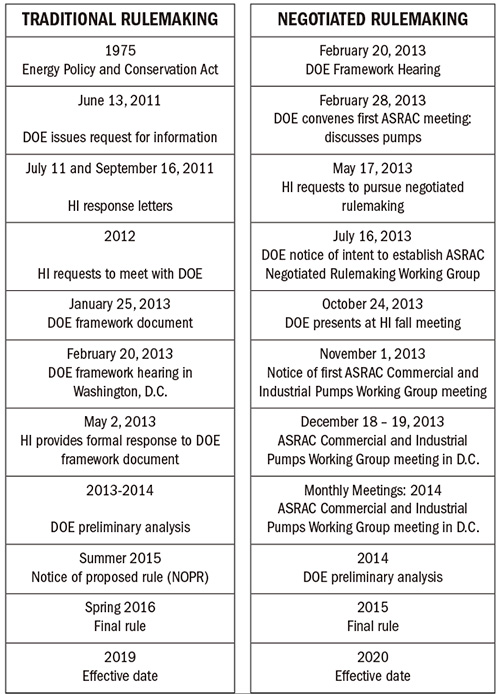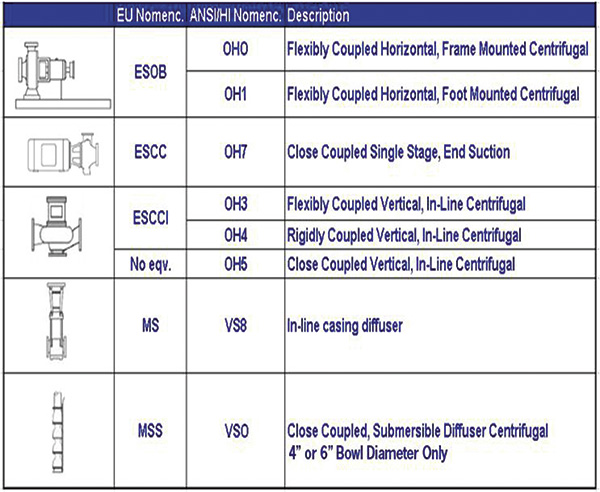These new regulations may include costly design improvements.
12/30/2013
This is the first of a three-part series (see part 2 here) that discusses the impending U.S. Department of Energy (DOE) pump efficiency regulations and how the Hydraulic Institute (HI) is working with its members, the DOE and other groups to reduce the burden on U.S. pump manufacturers while supporting DOE efforts to achieve energy savings and efficiency improvements in the marketplace.
The U.S. pump manufacturing industry has enjoyed a long history unfettered by federal regulations. As the DOE develops new regulations for pump efficiency, that will change. Mandatory pump rules are expected to take effect in 2016 and will begin to be enforced in 2019. Taking the lead in representing the pump industry, HI has communicated with the DOE since learning about the new rulemaking and, in December, met with its members to officially approve a new negotiated rulemaking process under the rules of the Appliance Standards Rulemaking Advisory Committee.
As DOE pump efficiency regulations are formulated, pump manufacturers should pay close attention to the direction in which the rules are headed and even begin defining actions that will ensure future compliance of their affected products. While the levels of pump efficiency defined by new regulations are uncertain, they will most likely involve design improvements. If the DOE models its regulations after the European Union (EU) standards, pumps not inherently efficient in their peer group across all companies that manufacture the same types of equipment will either be removed from the market or must be redesigned to meet higher efficiency levels.
While the outcome of these pump efficiency regulations is still uncertain, the DOE made it clear that Congress authorized them to set minimum efficiency standards for commercial and industrial pumps in 1977.
As the DOE regulatory process matures, it follows two paths—a traditional and negotiated approach (see Table 1)—that merit the attention of pump original equipment manufacturers (OEMs) and its future impact on their market.
HI Responds to the DOE
Since the DOE first announced its pump rulemaking plans three years ago in the Federal Register, HI members and staff have advocated for sensible regulations. Recognizing that regulations were inevitable, the group has been realistic in mitigating the impact on the pump industry, while supporting DOE energy savings and efficiency improvement goals. Table 1. The DOE rulemaking process
Table 1. The DOE rulemaking processThe Need for DOE Education—an Ongoing Opportunity
Through its interactions with DOE regulators, consultants and members of energy efficiency non-government organizations (EENGOs), HI realized that this audience was mostly unfamiliar with pump and pumping system operations. HI staff and members organized several briefings for all involved individuals to provide a better understanding of the complexities of pump operations, pump hydraulic design, and pump and system interaction. HI also offered day-long training on the HI and Pump Systems Matter course, “Pump Systems Matter: Energy Efficiency and Bottom-Line Savings.” In addition, HI met with energy efficiency non-government organizations and DOE consultants in Washington, D.C.; Dallas, Texas; Denver, Colo.; and Parsippany, N.J., to explore common ground and reach an agreement on regulatory approaches to energy savings regarding pumps and pumping systems. HI advocates a product scope similar to that adopted under EU pump regulations, along with a method of recognizing the pump system optimization potential to achieve the greatest energy savings. An independent agreement with EENGOs, which might have led to a DOE sanctioned rule, remained elusive during 2013. The possibility of rulemaking based on direct negotiations with other stakeholders, under DOE established rules, was then explored as the traditional rulemaking process advanced. The DOE’s framework document was released in January 2013, and HI members presented testimony during a day-long public hearing in Washington, D.C., at the end of February. A week later, HI delegates and staff attended the first meeting of the DOE’s Appliance Standards Rulemaking Advisory Committee (ASRAC). Prospects of a direct negotiation through an ASRAC Working Group on Pumps were explored by the HI board and were subsequently approved in May 2013, and the DOE organized this effort during the summer months and into the fall. DOE officials updated HI members at the fall meeting in Baltimore, Md., sharing insights into their process. The first meeting of the ASRAC Working Group on Pumps was held on December 18 and 19, 2013. As this negotiated rulemaking process unfolds, the DOE’s traditional rulemaking continued in earnest in 2013 and will continue in 2014 and 2015, leading to a final rulemaking in 2016. The ASRAC Working Group will continue its monthly meetings in 2014 to find common ground among its 16 members, leading to a possible direct and final rule that may come earlier than the traditional DOE rulemaking process timeline.Advocating for a Limited Product Scope
Since the DOE pump efficiency rulemaking began in early 2011, HI has advocated for a product scope relatively consistent with EU regulations. HI’s analysis of the U.S. pump market, reported to the DOE on May 2, 2013, confirmed, “that the variety of existing products and numerous market segments, each with unique requirements, is wide and complex as similar designs cross multiple market segments and are applied differently, resulting in a large number of unique product variations.” To capture the largest population of pumps that cost effectively produce the greatest energy savings, HI recommended aligning with directive EU No. 547/2012, which focuses on non-engineered/non-specialized pumps, in standard design, applied in clean-water-only applications for the broadest scope. Pump types covered by EU No. 547/2012 are outlined in Table 2 with their U.S. equivalents noted by the ANSI/HI nomenclature designation and description. HI has pressed for the use of HI standards for establishing well-understood pump industry reference documents, including pump test procedures. Table 2. Pump types
Table 2. Pump types- Only standard pumps of non-engineered/non-specialized design
- Only clean water (including grey water)
- 26 gallons per minute and greater, up to a maximum 459* feet total head (H)
- Horsepower range from 1 to 200
- Pumps designed to operate in a temperature range of -10 C to +120 C *Note: 295 feet is incorrectly stated as the maximum head in the DOE framework document (see page 8 for the incorrect reference. It should be 459 feet H). Pumps and liquids specifically excluded from the scope are positive displacement, fire pumps, self-priming, wastewater (no solids-handling) and circulators.

